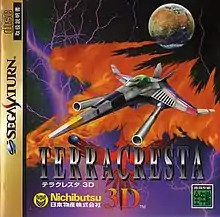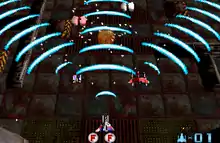Terra Cresta 3D
Terra Cresta 3D[lower-alpha 1] is a 1997 vertical-scrolling shooter video game developed and published by Nichibutsu for the Sega Saturn in Japan. The player assumes control of three starships as they must complete six stages while destroying enemies and avoiding collision with them and their projectiles. By collecting small "F" icons the player can merge the three ships into one and gain access to new, more destructive weapons. It is the seventh and final game in the Terra Cresta series, following the 1992 game Terra Cresta II for the PC-Engine.
| Terra Cresta 3D | |
|---|---|
 | |
| Developer(s) | Nichibutsu |
| Publisher(s) | Nichibutsu |
| Director(s) | Tacanoli Tanaca |
| Series | Terra Cresta |
| Platform(s) | Sega Saturn |
| Release | |
| Genre(s) | Vertical-scrolling shooter |
| Mode(s) | Single-player |
3D is the second entry in the series to have no involvement with creator Shigeki Fujiawara, who several years prior departed from Nichibutsu to work on the Bomberman series for Hudson Soft — this left the company struggling to produce any successful action-oriented titles, shifting focus towards pornographic mahjong arcade games instead. Terra Cresta 3D was negatively received for its gameplay, level design and inferiority to similar games on the platform, although its graphics and soundtrack were praised by some. It is one of Nichibutsu's final games, as they ceased their video game operations in the early 2000s.
Gameplay

Terra Cresta 3D is a vertical-scrolling shooter video game. Assuming the role of three different starships — the Winger, Gamma and Beta — the player is tasked with completing six stages by destroying enemies and avoiding collision with them and their projectiles.[2] The Gamma gives the player a tailgun that can fire forwards and backwards, and the Beta doubles the player's firepower.[3] These ships can be found by destroying small bases found throughout stages.[2]
By collecting small "F" icons from defeating enemies, the player can combine all three ships into one for increased power[2] — combining with one other ship gives the Winger a wave beam, and combining with two provides the Winger with heat-seeking lasers that automatically lock onto enemies.[3] The player can also launch a powerful screen-clearing bomb in the form of a flaming phoenix that glides across the screen.[3] Stages end with a boss that must be defeated to progress.[2] By performing a button combination on the main menu, the player can access a cheat giving them 99 lives at the beginning of the game.[4]
Development and release
Terra Cresta 3D was released in Japan by Nichibutsu for the Sega Saturn on August 8, 1997 in Japan.[5] It is the second Terra Cresta game to not have any involvement with series creator Shigeki Fujiwara, as several years prior he left Nichibutsu to work on the Bomberman series for Hudson Soft.[6] Described as "the heart and soul of the company" by Hardcore Gaming 101, his departure left Nichibutsu struggling to produce any successful action-oriented games, instead releasing a number of pornographic mahjong arcade titles throughout the late 1990s.[3] Terra Cresta 3D is one of the company's last video games alongside titles such as Battle Round USA, as they suspended their operations in the early 2000s.[3]
Reception
| Publication | Score |
|---|---|
| Famitsu | 19/40[1] |
| Next Generation |
Famitsu was negative towards the game's slow pace and inferiority to similar titles available on the Saturn, believing that the core gameplay of Terra Cresta was unsuitable for a 3D shooting game.[1] GameFan expressed a lukewarm response towards its slow pace and low difficulty level, although liked its polygonal graphics and soundtrack.[8] They compared it unfavorably to Namco's Xevious 3D/G.[8] Next Generation magazine was especially critical towards the game, finding its 3D visuals "pathetic" and its level designs "of the lowest, common-denominator, cookie-cutter, purple-blotchy-copy-of-every-other-shooter-known-to-mankind variety".[7] They especially disliked its usage of polygons due to it slowing down the game speed, and found the game to be a disappointment compared to the original Moon Cresta and Terra Cresta.[7] Next Generation suggested that players instead wait for Raizing's Terra Diver or Taito's RayStorm.[7] SuperGamesPower liked the idea of combining the player's ships together to form a much more powerful one, comparing it to arcade titles like Galaxian and Xevious.[9]
In a 2016 retrospective review, Jess Ragan of Hardcore Gaming 101 called it a "disconcertingly watered down sequel" to the original Terra Cresta, disliking its graphics, transparency effects, camera angle and overall gameplay for being inferior to other shooters on the Saturn and to earlier titles in the series.[3] The departure of series creator Shigeki Fujiwara was also cited by Ragan as a reason for the game's sudden downturn in quality compared to earlier entries, as well as the overall state of the video game industry at the time and impending dominance of 3D graphics.[3] He felt that it was "a miracle" that the game was even made due to Nichibutsu mainly devoting their video game operations towards pornographic mahjong arcade games towards the late 1990s.[3] Ragan also praised the soundtrack for its usage of orchestral remixes of tracks from the original, saying that had Nichibutsu put the same amount of effort into the game as they did with the music it "could have been something special".[3]
References
- "テラクレスタ3D (セガサターン)". Famitsu. Kadokawa Corporation. Archived from the original on 16 November 2019. Retrieved 16 November 2019.
- Terra Cresta 3D instruction manual. Japan: Nichibutsu. 8 August 1997.
- Ragan, Jess (21 August 2016). "Terra Cresta 3D". Hardcore Gaming 101. Archived from the original on 7 May 2019. Retrieved 16 November 2019.
- "テラクレスタ3D - これで絶対クリアーできる!?" (455). ASCII Corporation. Famitsu. 5 September 1997. p. 189. Retrieved 16 November 2019.
- "[セガハード大百科] セガサターン対応ソフトウェア(ライセンシー発売)". Sega. p. 3. Archived from the original on 28 July 2019. Retrieved 16 November 2019.
- Ragan, Jess (13 August 2016). "Terra Cresta II". Hardcore Gaming 101. Archived from the original on 17 April 2019. Retrieved 16 November 2019.
- "Terra Cresta 3D" (36). Next Generation. December 1997. p. 168. Retrieved 16 November 2019.
- E. Storm (October 1997). "E. Storm's Import Review" (Volume 5, Issue 10). GameFan. p. 137. Retrieved 16 November 2019.
- "Terra Cresta 3D" (in Portuguese) (28). SuperGamesPower. July 1997. p. 24. Retrieved 16 November 2019.